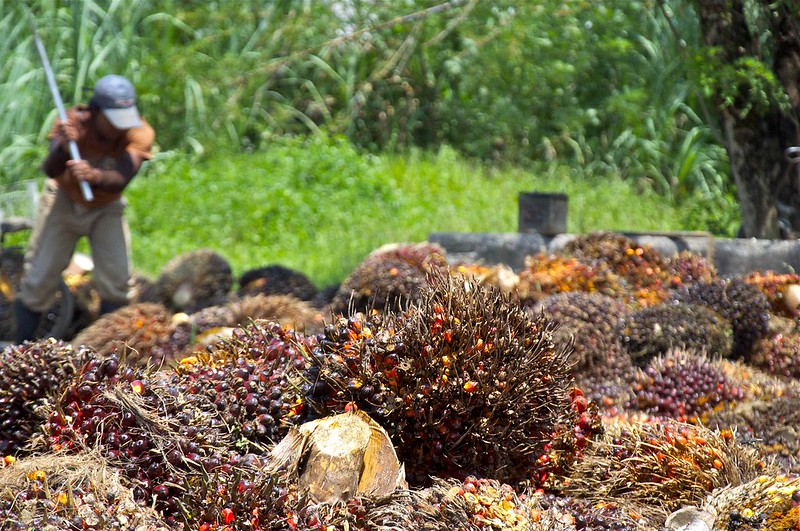The price of cooking oil in Indonesia has been on the rise since 2021. According to Detikcom, the price of packaged cooking oils reached IDR17,300/kg in October 2021. The rise of global CPO price was cited as the cause; Europe’s sunflower oil production has declined since 2020 due to the pandemic, so global sunflower oil customers sought out palm oil as an alternative.
In February 2022, the Indonesian government enforced legislation to ensure that the maximum price for branded cooking oils was set at IDR14,000 per liter (1 kg of oil = 1.1 liter of oil). The government also released 20% Domestic Market Obligation (DMO) regulations for cooking oil and CPO manufacturers. According to this regulation, corporations would have to spare 20% of their products to meet the demand of the national market.
The consequences
Soon after the regulations were enacted, cooking oil disappeared from the shelves of many supermarkets. To tackle the scarcity, some regional governments resorted to providing cheap cooking oil for low-income households. Cooking oil companies mentioned there was a delay in the distribution, rejecting the accusation that suggested they might have been hoarding their products.
In March 2022, to address the shortage problem, the government ended the price cap ruling. Soon after, palm oil products returned to the shelves. The trade minister blamed the cooking oil “mafia” for this, which drew criticism from internet citizens, who questioned his ability to do his job. Later, he promised to fix the problem, but people had gotten tired of this cooking oil drama. Ramadan drew near and the prices of grocery items tends to increase at that time. However, the previous oil shortage stunt had taught customers that pricy oil is better than no oil at all.
The ban
Driven by the instinct to maximize profits, palm oil manufacturers would rather send their products abroad. Many exporters argued that the government could still reap the benefit of export tax from this. The government insisted that they had to prioritize Indonesian customers so, when both sides could not reach an agreement, the government slapped them with a palm oil export ban (effective from April 28, 2022). The ban has made many opportunists commit to illegal activities.
This week, the Indonesian Navy stopped six ships carrying containers of palm oil products off the port of Medan, North Sumatra. They were captured for violating the export ban and DMO rules.
Better solutions?
Review the regulation
According to Info Sawit, 54% of palm oil plantations in Indonesia are owned by corporations; 41% owned by local holders/individuals; while the remaining 5% are owned by the government. Looking at production output, corporations produce about 51% of the whole CPO products.
The land ownership of a palm oil plantation is limited to 100,000 hectare per individual or company but this regulation doesn’t apply to companies that have owned over 100,000 hectare before the regulation was introduced in 2013. In reality, most plantations in Indonesia are owned by several conglomerates.
The government needs to review this regulation and seek the best way to improve it. See how effective it has been and if they can fix some loopholes. We don’t need more palm plantations or palm oil corporations.
This step may not solve the current problem we’re facing, but it will prevent us from having the same problem in the future.
Prioritizing the most urgent programs
Sonny Mumbunan, a researcher from the Research Center for Climate Change of Indonesia University, told Mongabay that the Indonesian government poured a lot of money into the biodiesel industry instead of more urgent issues, such as palm trees replantation programs for farmers and cooking oil subsidies.
Tenny Kristiana, Associate Researcher of International Council on Cean Transportation (ICCT), pointed that the total use of CPO by our biodiesel industry is far higher than the cooking oil industry. This will create scarcity in the future unless the government solves the problem now.
The government should also plan a budget to promote the importance of sustainability certification, such as ISPO (Indonesia Sustainable Palm Oil). To date, there are only 746 ISPO-certified companies in Indonesia.
Find different types of oils
Environmental activists have long voiced concerns over the palm oil industry. Lots of cooking oil alternatives have been introduced as a replacement but palm oil is still the most popular. Palm trees can yield more oil per hectare than any other plants, making them the most efficient oil-producing plant. In terms of land usage, palm trees are more environmentally friendly.
The palm oil industry cleared a lot of forests because there’s a huge demand for it. It has been long promoted as the best oil, after all. A high smoke point, no aftertaste, and very affordable. In short, it’s a perfect oil. The concentrated demand for a single product put a lot of burden on the environment. That is why diversity is needed.
Coconut oil has been labeled unhealthy by some but this is not true. Coconut oils can be a great alternative because coconut trees (Cocos nucifera) do not need as much water as palm trees (Elaeis guineensis Jacq.) do. Coconut trees are pretty low-maintenance and they don’t need fertilizers. All parts of the fruits can also be used for many household purposes.
Farmers can also look into other oil-producing plants and see if they have potential. Farmers also need to learn how to incorporate a reliable sustainability plan into their planting practices.
Image: Craig Morey

